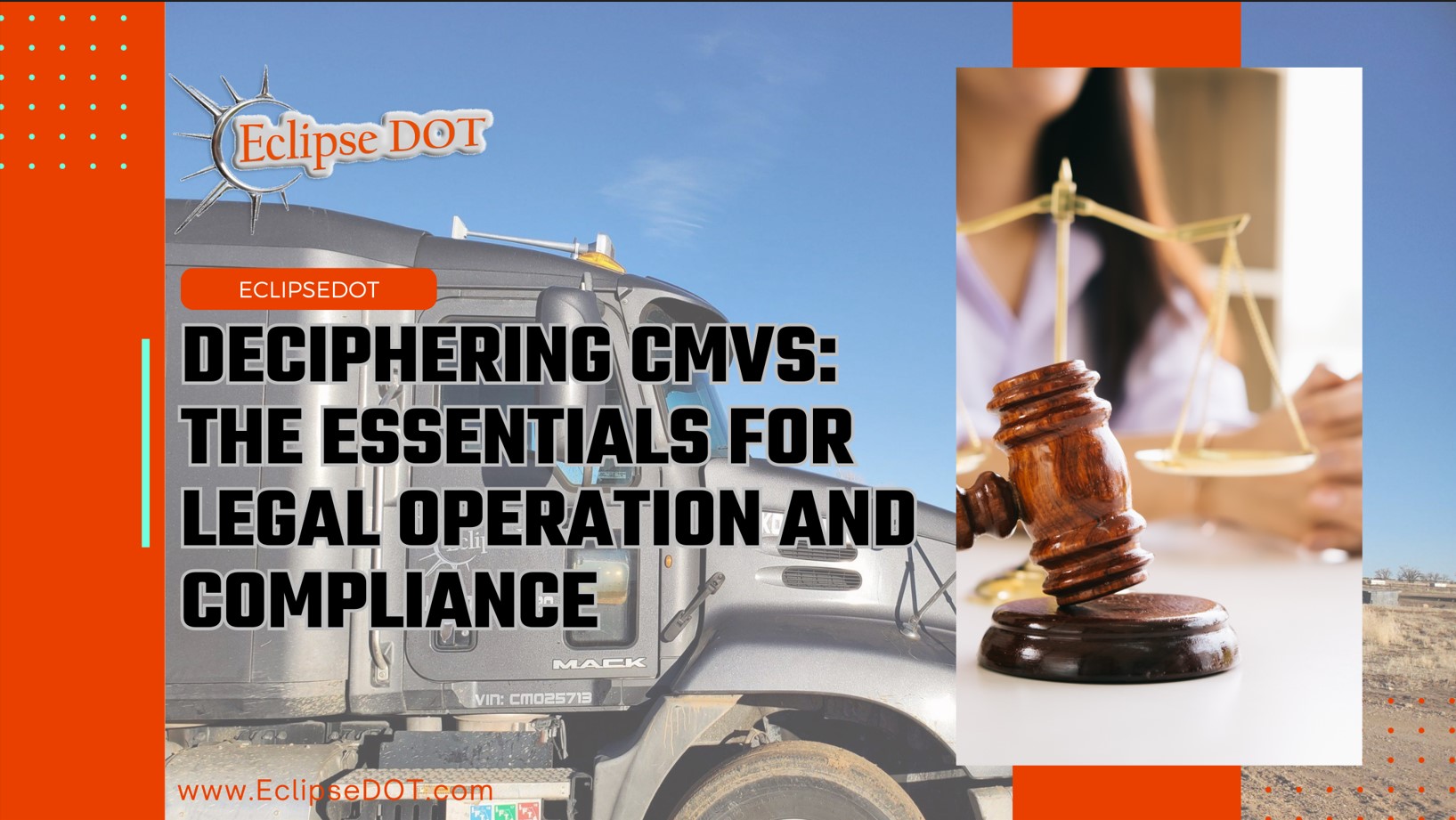Deciphering CMVs: The Essentials for Legal Operation and Compliance
Hey there reader, Dan Greer here! I wanted touch upon the world of Commercial Motor Vehicles (CMVs) and uncover the secrets that define a CMV and explore the checklist of essentials required for their legal operation. You already know I’m here to give you some good insights. I work with a TON of CMVs and also train drivers to drive them safely and properly. Let’s kick up your knowledge a bit while having a blast along the way!
Unraveling the Mystery of CMVs
Let’s kick things off by demystifying CMVs. What makes them stand out from the rest? Well CMVs have a Gross Vehicle Weight Rating (GVWR) of 10,001 pounds or more when crossing state lines. CMVs play a pivotal role in the world of commerce, ferrying goods and passengers with unparalleled precision and power. This means that these vehicles are what make the world go round.
From hauling materials for construction to hauling oil and gas, and an essential for commercial transportation. CMVs are critical to business operations worldwide. There’s a good chance you’ll see a CMV on the road at any given time!
Before we dive in, I want to share a quick checklist for legal CMV operations to help get you started. You might find it useful to share this with your team as well.
The Essential Checklist for Legal CMV Operation
Now that we’ve identified what CMVs are, let’s dive into the checklist of must-have essentials for every CMV to legally hit the road. These are what you definitely need to have in place in order to get down to business.
DOT Number: Think of DOT numbers as your CMV’s unique ID badge. Issued by the Department of Transportation (DOT), these numbers ensure that your vehicle is easily traceable and compliant with federal regulations. We’ve gone over DOT numbers before, so you might already know that this is your starting point when operating or preparing a fleet of CMVs for business.
Warning Triangles: These reflective warning triangles act as the red flags signaling, “Hey, CMV ahead!” They provide an extra layer of safety by alerting other drivers to your presence, especially during roadside emergencies. FMCSA regulations require CMVs to carry these triangles at all times! Don’t get caught without one because you might face a pesky penalty. And I don’t want that to happen to you!
Fire Extinguisher: Safety first, folks! The fire extinguisher is your trusty sidekick in combating unexpected flames, ensuring the safety of both your cargo and yourself. Accidents can happen, and of course, the FMCSA requires you to have one of these onboard. So make sure you have one with you at all times!
Spare Fuses: Every superhero needs a utility belt, and for a CMV, spare fuses play that role. These spare fuses prevent electrical mishaps, ensuring your vehicle runs smoothly without any hiccups.
Company Name/Insignia: Your company’s name or insignia on your CMV is more than just branding; it’s required alongside your DOT number. It’s a regulatory requirement to display your company’s information on your vehicle. After all, wouldn’t you want to show your company name with pride and who you drive for?
Annual Inspection: Just like your yearly health check-up, the annual inspection is crucial for your CMVs to operate safely on the road. It covers every nook and cranny, ensuring your vehicle remains roadworthy and compliant with safety standards. Want more information on vehicle maintenance and regulations? Well, I wrote a nifty guide to make sure you’re all caught up. You can read it here
Hazardous Materials (HazMat) Placards: If your CMV transports hazardous materials, HazMat placards are non-negotiable. These placards communicate the nature of your cargo, ensuring safe handling and transportation. FMCSA regulations provide extensive guidelines for HazMat transportation and take these placards very seriously. I know I always stress penalties and violations, but it’s important to make sure you are carrying these placards alongside everything else. One violation could lead to two, and so on, now tack on expensive fines to each one of those violations and you’re going to be wishing you were well prepared for hitting the road!
Cargo Securement Equipment: Properly securing your cargo is important for safety on the road. But you already know this! Straps, chains, and tie-downs are your trusted allies in ensuring your precious cargo arrives at its destination intact. Cargo securement should be one of the top priorities for any of your drivers before they hit the road.
I hope you found this checklist helpful! I always tell drivers that I train to make sure they are all in tune with these items so that they stay compliant. For owners, it’s important to train not only your drivers but also your team so that they’re in the know so that you can stay compliant at all times.
The Significance of Compliance
The items from the checklist form the backbone of compliance and safety in the realm of CMVs. Compliance ensures smooth operations, minimizes risks, and ensures the efficient delivery of goods. On top of that, you safeguard your business from any potential violations that may arise from not having these onboard.
Operating a CMV in compliance with regulations not only keeps you on the right side of the law but also fosters a culture of safety. Safe CMVs mean safer roads for everyone, from drivers to pedestrians. DOT compliance enhances the efficiency of cargo transportation, reducing the likelihood of delays due to unexpected hiccups. Time is money we all know that. Why would you risk slowing down your operation because you weren’t prepared to hit the road safely? Don’t risk it!
I hope you absorbed as much knowledge as you could from all of this. I always make sure that I sprinkle in some good stuff so that you can take it and share with your team, which I highly encourage! We covered quite a bit including figuring out what classifies a CMV uncovering what sets them apart and the essentials required for legal operation.
Remember, a well-prepared CMV isn’t just a compliant one; it’s a vehicle primed for safe and efficient journeys on our highways! Stay safe out there and happy truckin’!
Looking to dive deeper into CMV regulations or have questions about these essentials?
Contact us today to gain more insights and embark on your journey toward mastering CMVs.
Discover our CDL & DOT Compliance articles for an exclusive trial at DOTDocs.com. Also, claim your FREE micro audit at THE ECLIPSE DOT MICRO AUDIT. Ready for smoother operations?






2 thoughts on “Deciphering CMVs: The Essentials for Legal Operation and Compliance”
It’s actually a great and useful piece of information. I am satisfied that you shared this helpful info with us.Please stay
us informed like this. Thanks for sharing. https://www.waste-ndc.pro/community/profile/tressa79906983/
Hi there! This is my first comment hete so I just wanted to give a
quick shout out and say I genuinely enjoy reading your posts.
Caan you suggest any other blogs/websites/forums that deal with the same topics?
Thanks a lot! https://www.waste-ndc.pro/community/profile/tressa79906983/